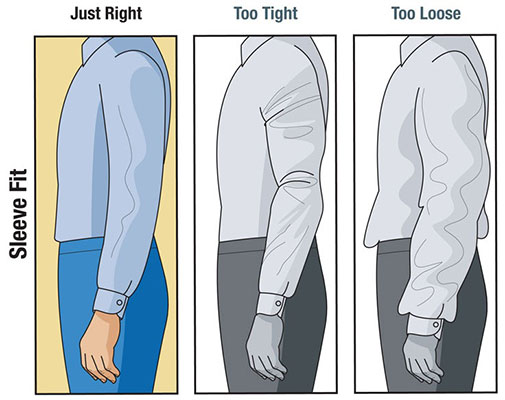The Perfect Fit
Shirts
How should a dress shirt fit?
It seems like a simple question — yet look around you. The vast majority of men are wearing dress shirts that are one to two sizes too large.
Why does this matter?
Simply put, — an ill-fitted dress shirt:
- is uncomfortable; and
- makes you look sloppy.
Collar Fit
Just right: The perfect collar fit touches the skin all the way around the neck, but does not press against it. You should be able to slip a finger in between your neck and the shirt at any point without struggling or forcing.
Too tight: The collar is close enough to actually press against the skin underneath it. There's a discernible sensation of constriction. It would be impossible to put a finger between the neck and collar without stretching, tugging, or forcing.
Too loose: The collar does not touch the neck, but rather rests off the body. You could slip a finger in next to the next without moving the cloth at all.

Shoulder Fit
Just right: The vertical shoulder seam sits at the edge of the shoulder, where the plane of the shoulder meets the plane of the outer arm. The armscye (the hole where the sleeve joins the shirt body) is large enough that there's no tugging or twisting on the shoulder seam.
Too tight: The seam will be shifted up the shoulder toward the neck. Some of the sleeve rests on top of the shoulder. If the tightness is in the armscye, there may also be twisting that causes wrinkles or distortion along the seam.
Too loose: The shoulder seam slumps off the shoulder, down onto the outside of the bicep. There may be billowing under the arm as well, if the armscye is too big.

Torso Fit
Just right: The buttons close comfortably and the underside of the placket (the strip where the buttons and buttonholes are located) rests lightly against the sternum (the central bone of your ribcage). The shirt tucks in wit no billowing at the sides.
Too tight: The buttons straight to close, causing radiating wrinkles around the buttonholes. Tightness may also cause pulling on the sleeves, distorting the armscye and shoulder seams.
Too loose: Excess fabric hangs slack around the stomach or chest, causing visible billowing. The shirt placket moves about and does not rest against the sternum. Tucking the shirt in causes billowing, ballooning, or "muffin-topping" near the trouser waist.

Sleeve Fit
Just right: The sleeve is slightly wider at the upper arm than the cuff, with a smooth, even taper. There should be some looseness when the arm hangs straight (so that the elbow isn't constricted when the arm bends). Looseness should be evenly distributed, not bunched up at the shoulder or cuff.
Too tight: The fit is snug when the arm hangs straight, causing pinching when the elbow or shoulder moves. Tautness may cause radiating wrinkles at the shoulder seam or elbow.
Too loose: There is so much slack that gravity pulls it downward and creates hanging folds of cloth, especially around the cuff. Loose sleeve fabric can also flap and sway around the elbow and bicep.

Sleeve Cuff
Just right: The cuff is close to the body but allows a bit of space between the cuff and the skin. It should be possible to put the shirt on or take it off without unbuttoning the cuffs. Enough room for a pair of fingers (or for a normal-sized dress watch) is a good amount of slack.
Too tight: It is impossible to pull the shirt off without unbuttoning the cuffs (or popping a button). The cuff presses against the skin all the way around the wrist. Wrist watches can only be worn below the hem of the cuff, and the cuff bunches up if it meets them rather than sliding over the watch.
Too loose: The cuff is wide enough that it can slide loosely over a wristwatch and still have room for several fingers to be inserted between the cloth and skin. Folds or wrinkles form in the fabric of the cuff when the arms are rested against the surface like a tabletop.

Sleeve Length
Just right: The sleeve comes all the way down to the large wrist bone at the base of the pinky/ring fingers. If a jacket is worn, about a half-inch of shirt cuff should show beyond the end of the jacket sleeve. The cuff should at least touch (and in some postures cover) the wristwatch, if one is worn.
Too short: The cuff leaves the wrist bones exposed, or is hidden completely beneath jacket sleeves.
Too long: The cuff falls all the way to the point where the hand begins to widen outward from the wrist. This can cause bunching if the sleeves are so long that slack piles up behind the point where the cuff stops. If a wristwatch is worn, it is completely covered by the sleeve at all times.

Bottom Hem Length
Just right: When untucked, the hem falls far enough to cover the belt. It should be long enough at all points (including the sides, if the hems are scalloped) to tuck at least an inch or so into comfortably-worn trousers.
Too short: The untucked shirt does not completely cover the belt or waist of the trousers. When tucked in, points of the hem remain exposed, or have so little cloth tucked in that they are likely to pop out when the body moves and bends.
Too long: The shirttails fall all the way to cover the crotch in front or bottom in back. When tucked in, excess fabric has to be shoved down between the legs to hide bunching up.
